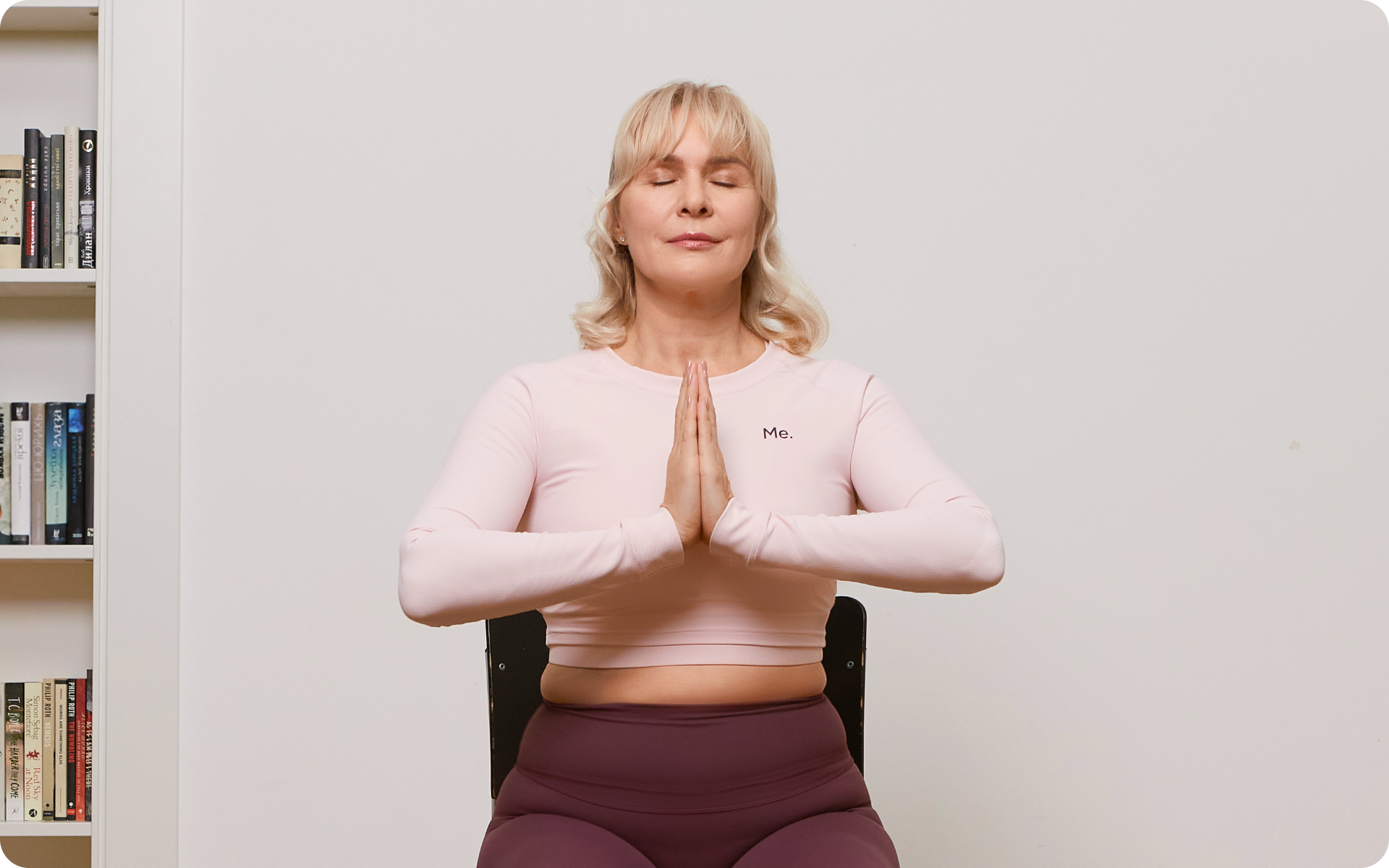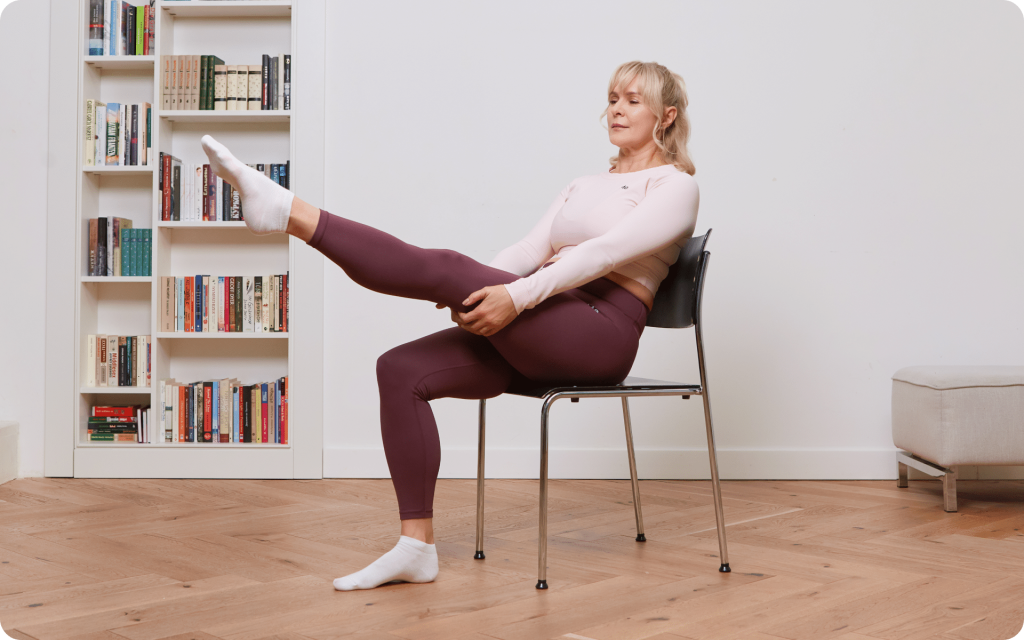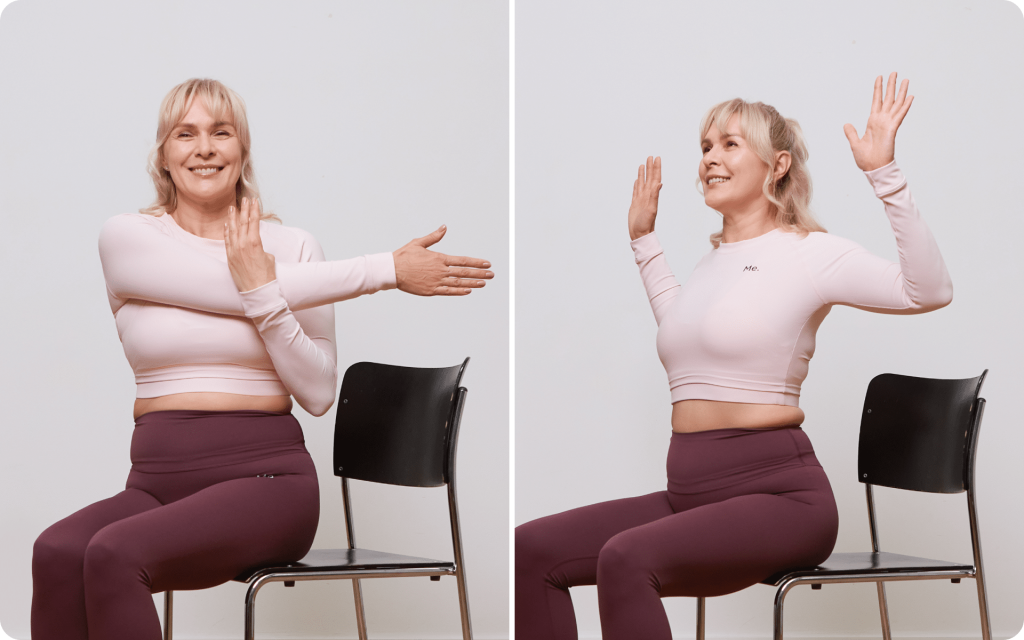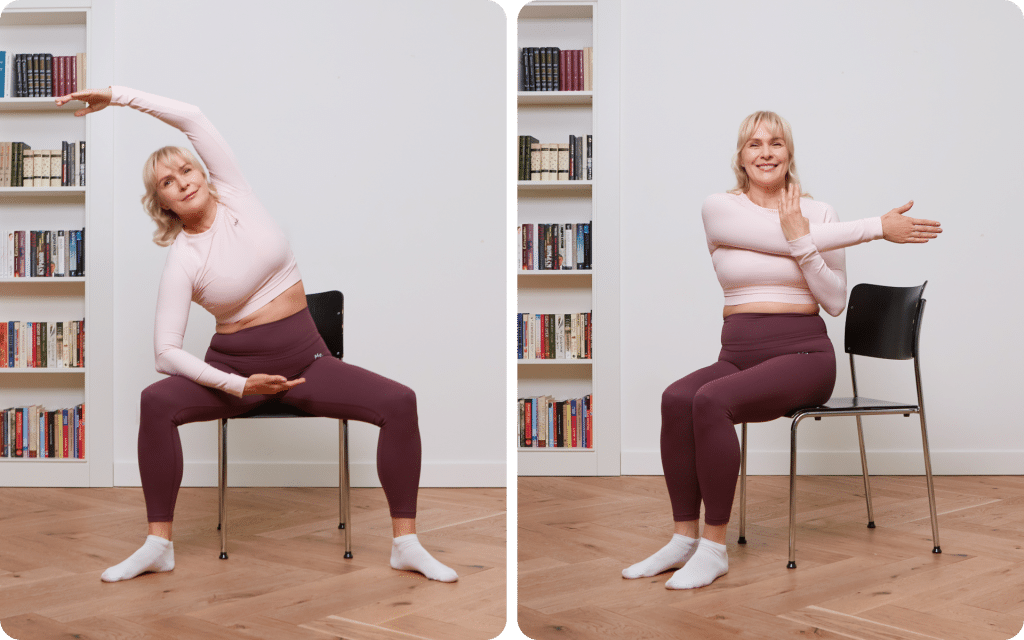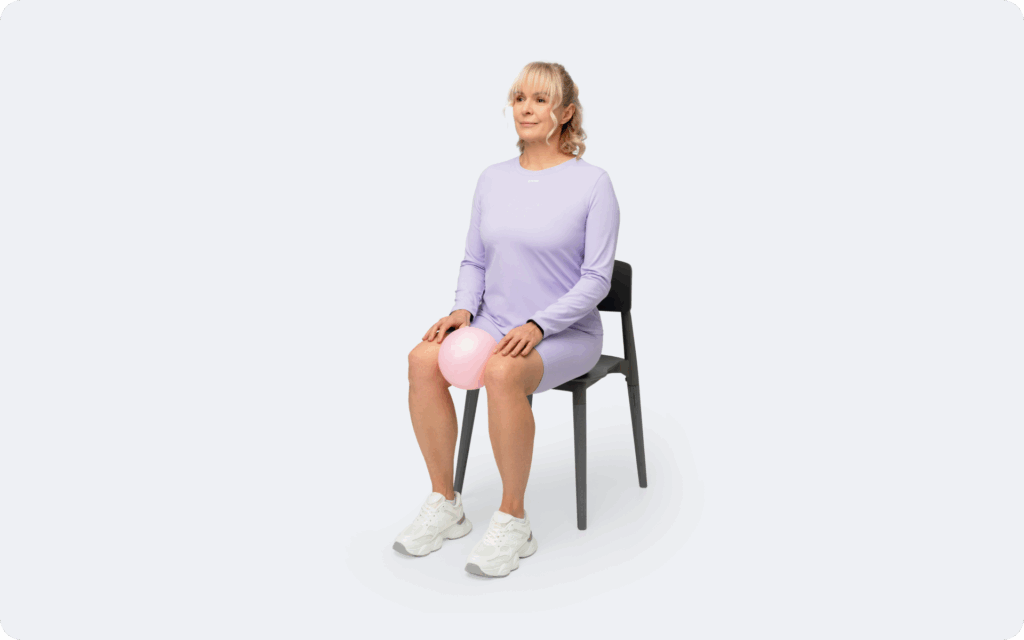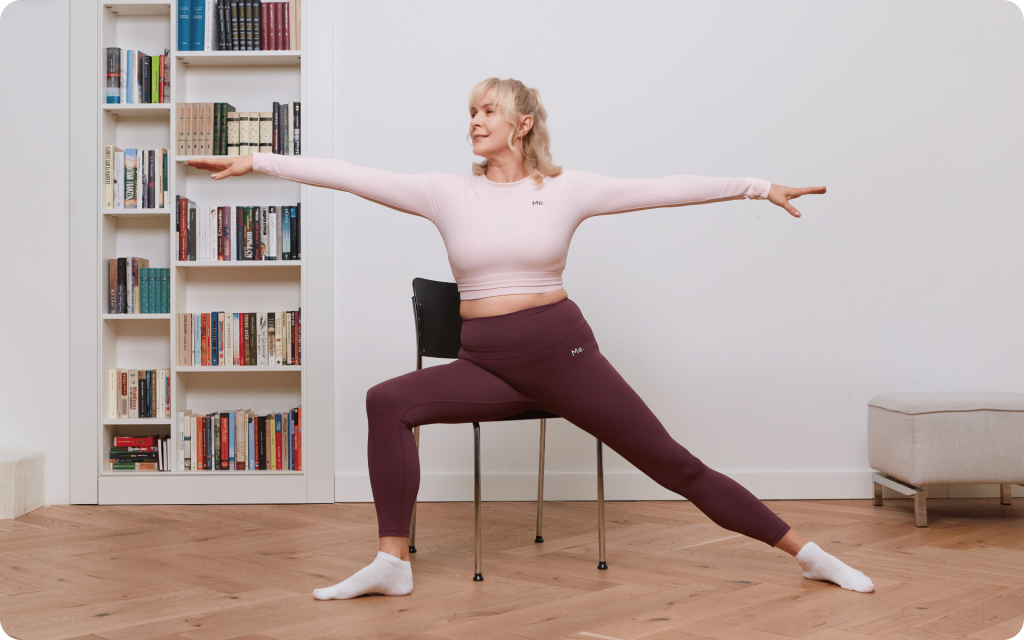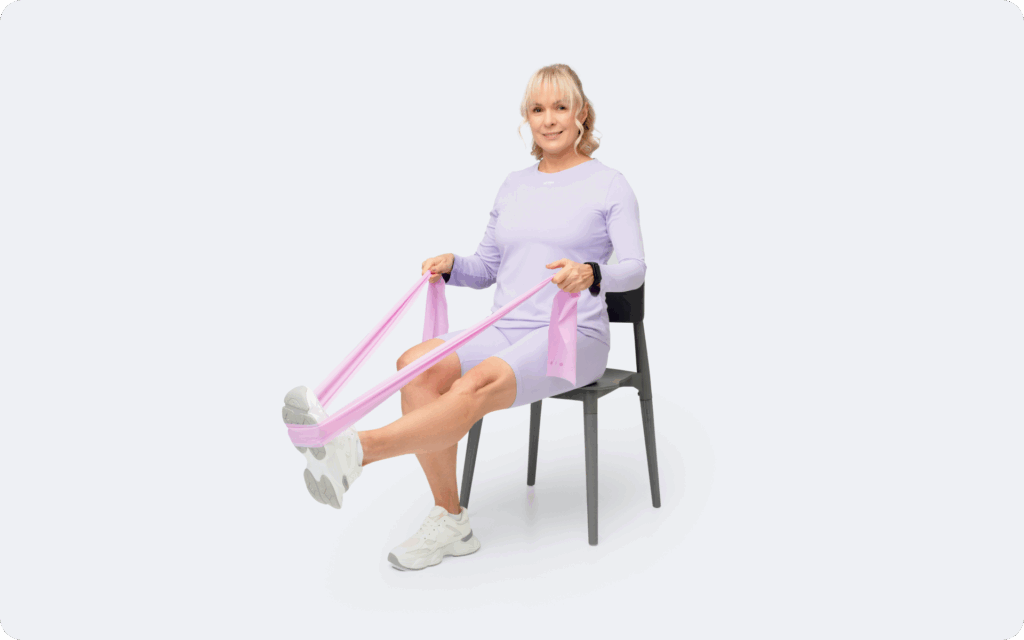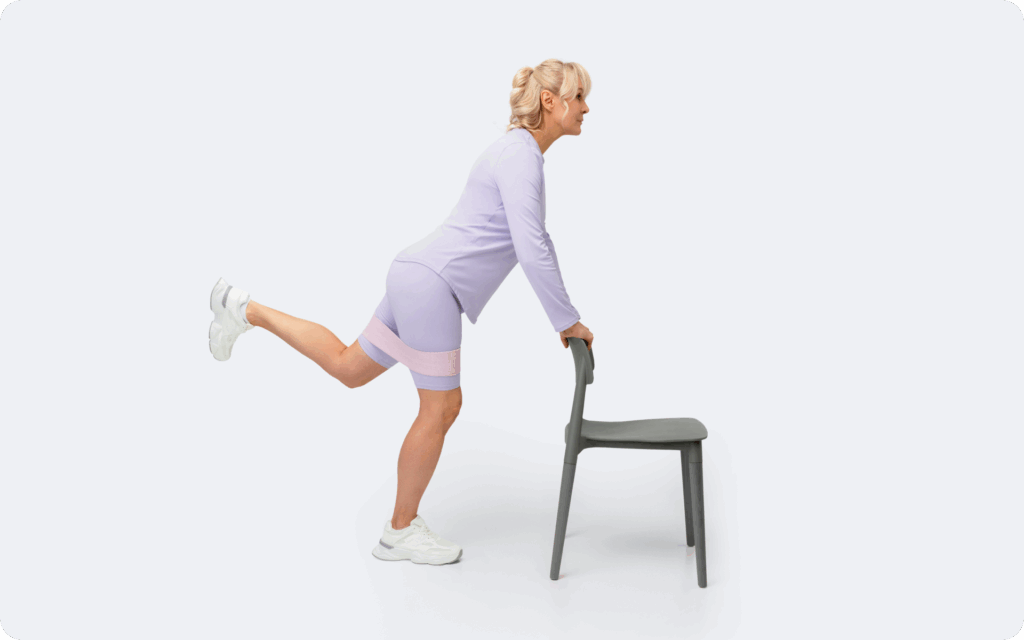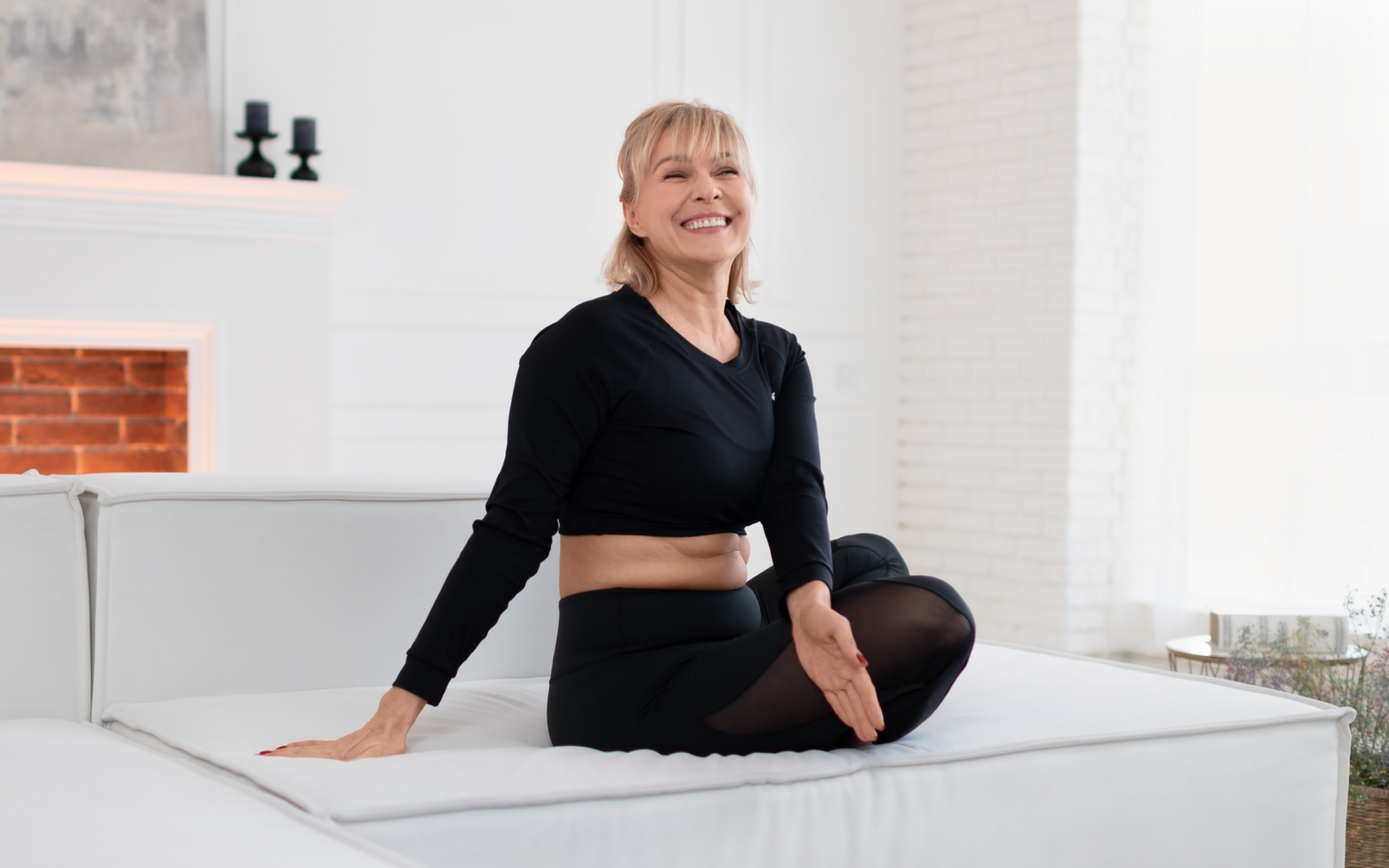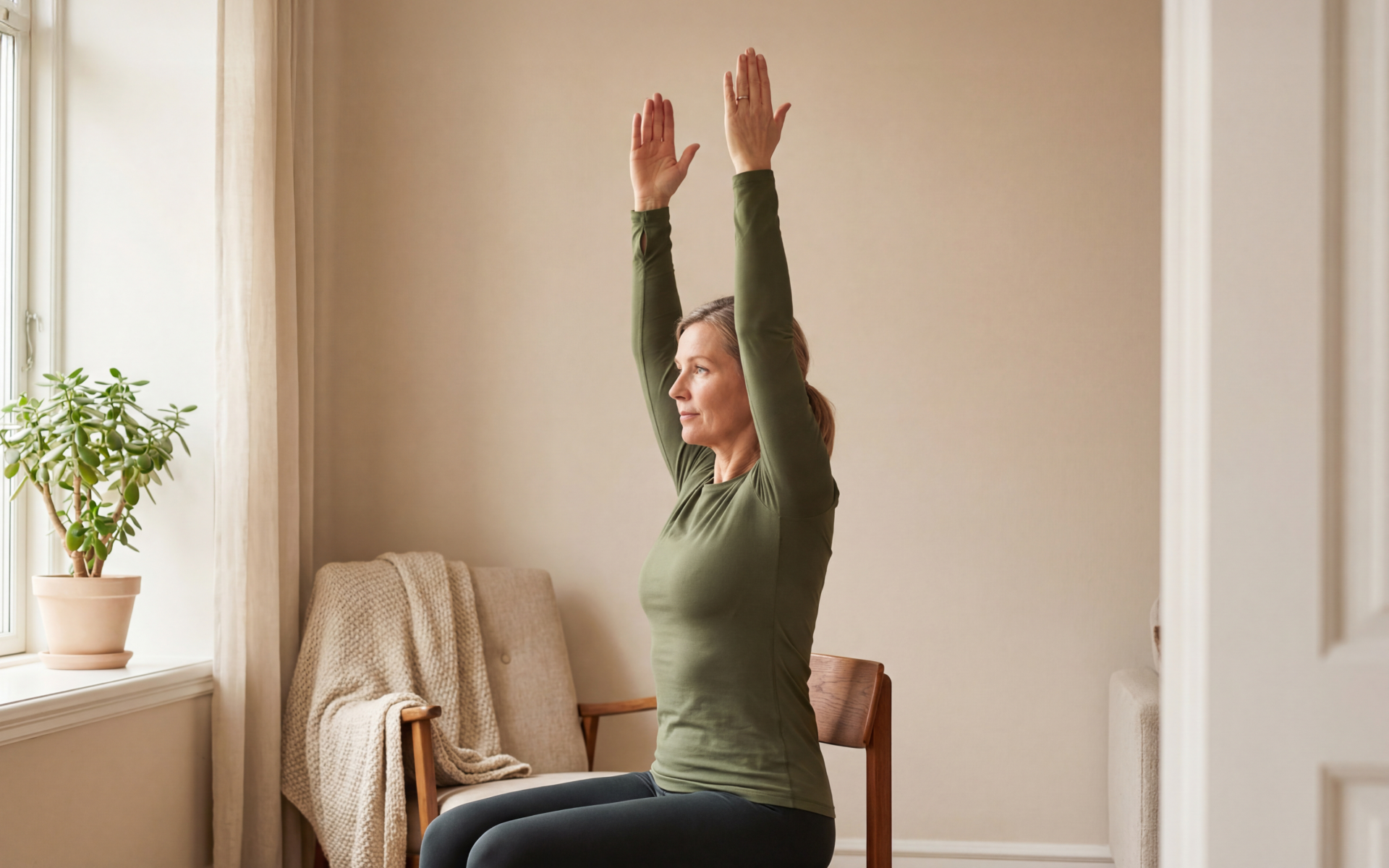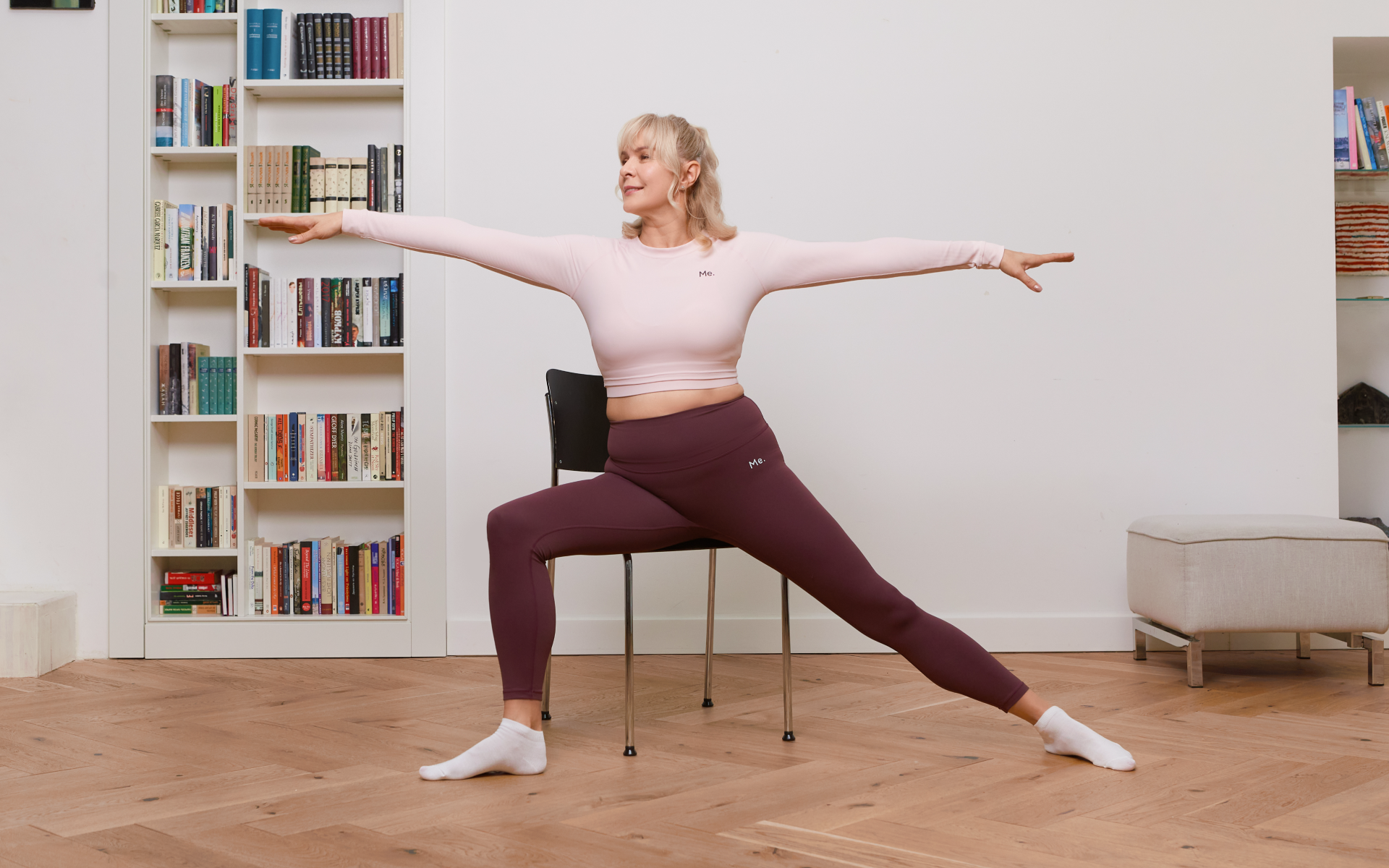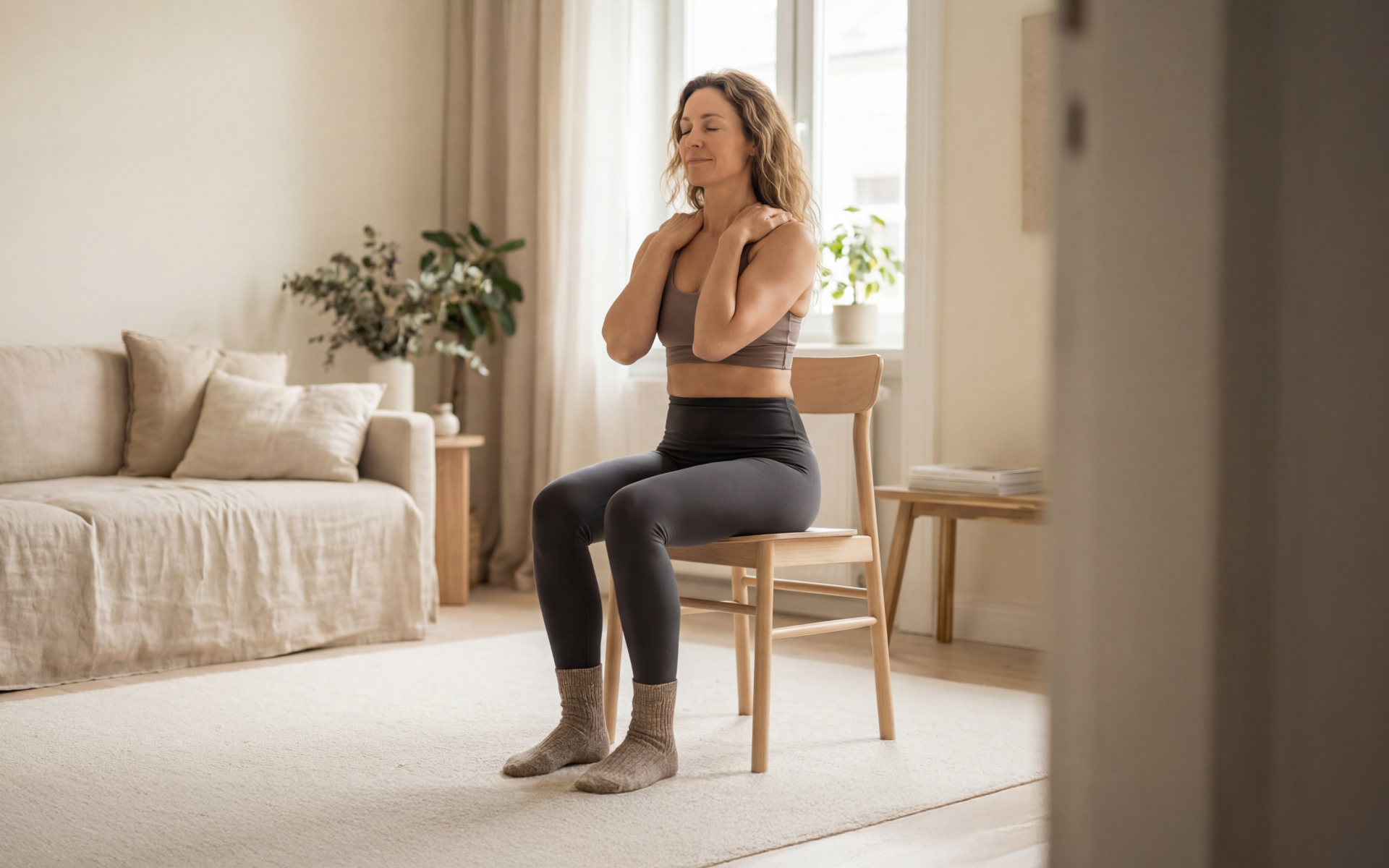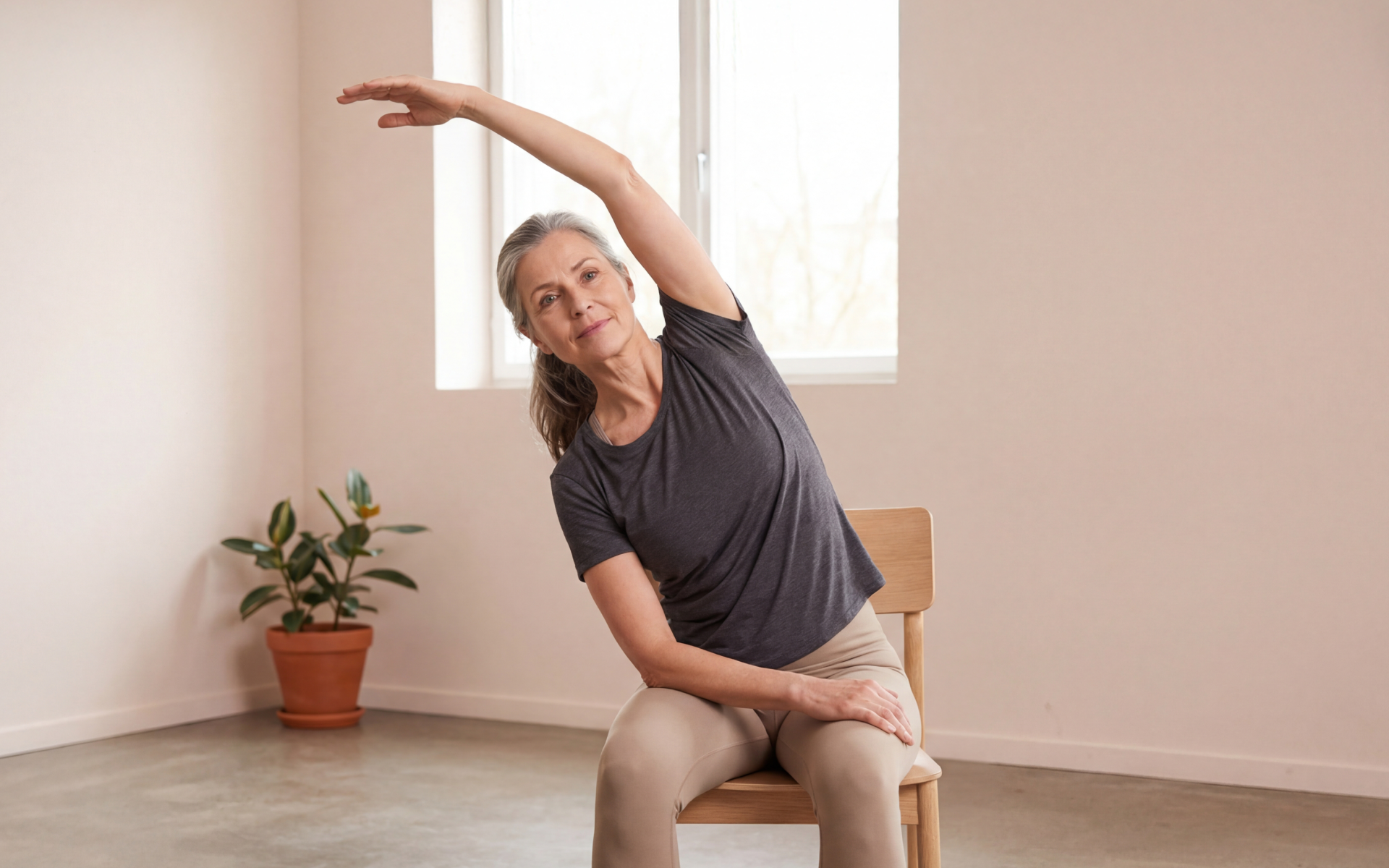Mobility challenges don’t have to define your golden years. Chair yoga offers seniors a gentle, accessible path to improved flexibility, reduced stiffness, and enhanced well-being – all from the comfort and safety of a seated position.
As we age, maintaining an active lifestyle becomes increasingly important for both physical and mental health. The World Health Organization recommends at least 150 minutes of moderate-intensity aerobic activity per week for adults aged 65 and older, plus muscle-strengthening activities on two or more days.
Chair yoga can be an excellent component of this recommended activity, providing a low-impact way to stay mobile and strong.
Here are 7 chair yoga exercises seniors can use as part of their routines.
Does Chair Yoga Count as Exercise?
Exercise is defined as planned, structured, repetitive physical activity performed to improve or maintain one or more components of physical fitness (1).
Ultimately, exercise should involve bodily movement and increase energy expenditure above rest.
Chair yoga involves deliberate movement patterns that engage multiple muscle groups, elevate heart rate modestly, and specifically target flexibility, balance, strength, and coordination.
A controlled study of women aged 65 and older with knee osteoarthritis who practiced chair yoga twice weekly for 12 weeks demonstrated notable improvements in functional fitness, including muscle strength, flexibility, and balance (2).
Unlike passive activities, chair yoga requires active muscle engagement and controlled movements that challenge your body’s systems. The sustained holds in poses (typically 30-60 seconds) build muscular endurance, while the flowing transitions between postures provide cardiovascular benefits.
A small pilot study published in the Journal of Alternative and Complementary Medicine found that seniors who practiced chair yoga for 45 minutes twice a week showed significant improvements in pain management, physical function, and quality of life compared to control groups (3).
Read more: The Ultimate 30-Minute Chair Yoga Routine For Every Body
Does Chair Yoga Really Work for Seniors?
Chair yoga delivers substantial benefits that are specifically tailored to the unique physical and mental needs of seniors. Here are eight evidence-based benefits that make chair yoga particularly effective for older adults:
- Improves Balance and Stability
Chair yoga enhances proprioception – your body’s ability to sense its position in space. This is essential for seniors, as balance naturally declines with age. The seated position provides a stable base while still challenging your core stability muscles.
Studies have shown that seniors who practice chair yoga experience noticeable improvements in fear of falling and mobility, a key indicator of fall risk reduction (3, 4). Chair yoga is also an incredibly safe option for those with a history or fear of falling.
- Reduces Joint Stiffness
Gentle, controlled movements in chair yoga help maintain joint range of motion without placing excessive stress on arthritic or sensitive joints. The warm-up effect of movement increases synovial fluid production, naturally lubricating joints and reducing morning stiffness (5).
Reasons why BetterMe is a safe bet: a wide range of calorie-blasting workouts, finger-licking recipes, 24/7 support, challenges that’ll keep you on your best game, and that just scratches the surface! Start using our app and watch the magic happen.
- Strengthens Core Muscles
Many chair yoga poses engage deep abdominal and back muscles essential for posture and stability (6). A stronger core translates to better posture, reduced back pain, and improved functional movement in daily activities (7).
- Enhances Flexibility Safely
Chair yoga addresses flexibility limitations common in seniors, particularly in the spine, hips, and shoulders (8). The seated position allows for controlled stretching without the fear of falling or losing balance.
- Improves Circulation
The gentle movements and breathing exercises in chair yoga promote blood flow, which is particularly beneficial for seniors who may spend long periods sedentary. Enhanced circulation can reduce swelling in the legs and feet and improve overall cardiovascular health (9).
- Reduces Chronic Pain
Chair yoga’s combination of gentle movement, stretching, and relaxation techniques can significantly reduce chronic pain conditions that are common in seniors, including arthritis, fibromyalgia, and lower-back pain (3).
- Boosts Mental Health
The mindfulness component of chair yoga helps reduce anxiety and depression while improving cognitive function. The social aspect of group classes also combats isolation, which is a significant health concern for many seniors (10).
- Supports Better Sleep
Regular chair yoga practice helps regulate the nervous system, promoting deeper, more restorative sleep. The relaxation techniques learned in practice can be applied at bedtime to improve sleep quality (11).
For more comprehensive information about these benefits, explore our detailed guide to chair yoga benefits for seniors.
Can You Lose Weight Doing Chair Exercises?
While chair yoga isn’t primarily designed for weight loss, it can complement a comprehensive weight management program for seniors in several meaningful ways:
Caloric Expenditure: A 45-minute chair yoga session burns approximately 105-147 calories in seniors, depending on your body weight and intensity level (12). While modest compared to high-impact activities, this represents meaningful energy expenditure for seniors with mobility limitations.
Muscle Mass Preservation: Chair yoga helps maintain lean muscle mass, which is essential for seniors (13). After the age of 30, we lose 3-8% of muscle mass per decade, and this loss accelerates after the age of 60 (14). Maintaining muscle mass keeps your metabolism higher, which supports weight management efforts (15).
Appetite Regulation: The stress-reduction benefits of chair yoga may help regulate cortisol levels (16), which can influence appetite and food cravings. Lower stress levels often lead to more mindful eating choices (17).
Improved Mobility: As chair yoga improves flexibility and reduces stiffness, many seniors find themselves more willing and able to engage in other forms of physical activity, which creates a positive cycle of increased movement (8).
Better Sleep: Quality sleep is essential for weight management, as poor sleep may disrupt hormones that regulate hunger and satiety (18). The relaxation benefits of chair yoga often improve sleep quality (11).
For optimal weight management, chair yoga should be combined with cardiovascular exercise (as tolerated), resistance training, and proper nutrition guidance from healthcare providers.
Read more: Seated Chair Yoga for Seniors: A Complete Guide to Safe Movement
What Are Some Gentle Chair Yoga Exercises for Seniors?
Here are seven carefully selected chair yoga exercises that address common areas of stiffness while being accessible to most seniors:
Seated Mountain Pose (Modified Tadasana)
This foundational pose establishes proper posture and body awareness.
Steps to perform:
- Sit tall in your chair with your feet flat on the floor, hip-width apart.
- Place your hands on your thighs with your palms facing down.
- Roll your shoulders back and down, lengthening your spine.
- Tuck your chin slightly to align your head over your shoulders.
- Take 5-8 deep, slow breaths, focusing on the sensation of grounding through your sitting bones.
- Hold for 1-2 minutes while maintaining the upright posture.
Seated Cat-Cow Stretch (Modified Marjaryasana-Bitilasana)
This movement addresses spinal stiffness and improves posture flexibility.
Steps to perform:
- Sit forward in your chair with your hands on your knees.
- Inhale, arch your back gently, lift your chest, and look slightly upward (cow position).
- Exhale, round your spine, tuck your chin to your chest, and gently contract your abdominal muscles (cat position).
- Move slowly between these positions, coordinating with your breath.
- Perform 8-12 slow, controlled repetitions.
- Focus on moving one vertebra at a time.
Seated Spinal Twist (Modified Bharadvajasana)
This gentle twist improves spinal mobility and aids digestion.
Steps to perform:
- Sit sideways in your chair with your right hip against the chair back.
- Place both hands on the chair back for support.
- Slowly twist your torso toward the chair back, starting from your lower spine.
- Hold for 30-45 seconds, breathing deeply.
- Return to center slowly and repeat on the opposite side.
- Keep the twist gentle – you should feel a pleasant stretch, not strain.
Intense sweat sessions, working weight loss tips, lip-smacking recipes come in one package with the BetterMe: Health Coaching app—all at your fingertips, start transforming your life now!
Chair-Supported Warrior I (Modified Virabhadrasana I)
This pose strengthens the legs while improving hip flexibility.
Steps to perform:
- Sit sideways on the chair with your right side facing the chair back.
- Extend your left leg back, keeping your left foot flat on the floor if possible.
- Hold the chair back with your right hand for support.
- Raise your left arm overhead, creating a gentle side stretch.
- Hold for 30-60 seconds, breathing steadily.
- Switch sides and repeat with your right leg extended back.
Seated Forward Fold (Modified Uttanasana)
This pose stretches the back of your body while being safe for those with osteoporosis concerns.
Steps to perform:
- Sit toward the front edge of your chair with your feet hip-width apart.
- Place your hands on your thighs and slowly hinge forward from your hips.
- Keep your back straight – avoid rounding your spine.
- Let your hands slide down your legs as far as comfortable.
- Hold for 30-45 seconds, breathing deeply.
- Use your hands on your thighs to help you return to an upright position.
Seated Eagle Arms (Modified Garudasana)
This pose addresses shoulder stiffness and improves upper-body circulation.
Steps to perform:
- Sit tall with your feet flat on the floor.
- Extend both arms out to the sides at shoulder height.
- Cross your right arm under your left arm at the elbows.
- Bring your palms together if possible or rest the back of your hands together.
- Gently lift your elbows while dropping your shoulders away from your ears.
- Hold for 30-45 seconds, then repeat with your left arm under your right arm.
Ankle Circles and Calf Stretch
This exercise improves circulation and addresses lower leg stiffness.
Steps to perform:
- Sit back in your chair with good posture.
- Extend your right leg out straight, keeping your heel on the floor.
- Point and flex your foot 8-10 times.
- Make slow circles with your ankle, 8 times in each direction.
- For the calf stretch, flex your foot and gently pull your toes toward your shin.
- Hold the stretch for 30 seconds, then repeat with your left leg.
For additional seated exercise options, check out our comprehensive guide to seated chair exercises for seniors.
How Many Times a Week Should a Senior Do Chair Yoga?
According to the guidelines for older adults from the Centers for Disease Control and Prevention (20), seniors should aim for:
- 150-300 minutes of moderate-intensity aerobic activity per week (or 75-150 minutes of vigorous-intensity activity).
- Muscle-strengthening activities involving major muscle groups on 2 or more days per week.
- Balance and coordination activities on 3 or more days per week.
Chair yoga can effectively contribute to all three categories. Here’s how to integrate chair yoga into this framework:
Beginner Level: Start with 15-20 minute sessions, 2-3 times per week. This allows your body to adapt while establishing a consistent routine.
Intermediate Level: Progress to 30-45 minute sessions, 3-4 times per week. You can alternate between gentle flow sessions and more focused strength-building practices.
Advanced Level: Practice 45-60 minutes, 4-5 times per week, incorporating varied sequences that challenge different aspects of fitness.
Daily Practice: Short 10-15 minute daily sessions focusing on gentle movement and breathing can be beneficial, especially for addressing morning stiffness or evening tension.
Chair yoga complements other forms of exercise that are recommended for seniors, such as walking, swimming, or resistance training. It can serve as an active recovery option on days between more intense activities or as a standalone practice for those with significant mobility limitations.
The key is consistency rather than intensity. Regular, gentle practice yields better long-term results than sporadic intense sessions.
For a structured approach to building your practice, explore our chair yoga sequence for seniors.
Absolutely. Chair yoga provides significant benefits for seniors with minimal risk of injury. Research has consistently shown improvements in flexibility, strength, and mental well-being among seniors who practice chair yoga regularly. The accessibility of chair yoga makes it particularly valuable for seniors who are unable to participate in traditional exercise programs due to mobility limitations, balance concerns, or chronic conditions (2). The low-impact nature means it’s suitable for those with arthritis, osteoporosis, or joint replacements, while still providing meaningful physical and mental health benefits. Chair yoga isn’t necessarily “better” than traditional yoga, but it’s often more appropriate and accessible for many seniors. The seated position provides stability and reduces fall risk, which makes it safer for those with balance issues or mobility limitations. Chair yoga eliminates the need to get up and down from the floor, which can be challenging or impossible for some seniors. It also allows for easier modifications and the use of the chair as a prop for support. However, seniors who are comfortable and capable may benefit from combining both chair yoga and traditional yoga practices, using chair yoga on days when they need gentler movement. Yes, chair yoga can help tone your body, although results will be more subtle than high-intensity strength training. Chair yoga exercises that require you to hold positions against gravity, engage your core for stability, and use resistance from your own body weight do provide muscle-strengthening benefits. The sustained holds in poses such as chair warrior I or seated mountain pose engage multiple muscle groups simultaneously, building both strength and endurance. Core muscles, in particular, are constantly engaged during chair yoga to maintain proper posture and stability. While chair yoga may not build significant muscle mass, it effectively maintains existing muscle tone and can prevent the muscle loss (sarcopenia) that commonly occurs with aging. Chair squats in yoga for seniors typically refer to a modified version of the traditional squat that uses a chair for support and guidance. The most common version is the chair rise pose or seated-to-standing transition: Basic chair squat: This exercise strengthens the quadriceps, glutes, and core muscles while improving functional movement patterns that are essential for daily activities. The chair provides a target depth for the squat and a safety net, which makes it appropriate for seniors of varying fitness levels.Frequently Asked Questions
Is chair yoga for seniors worth it?
Is chair yoga better than regular yoga for seniors?
Can chair yoga tone your body?
What are squats in chair yoga for seniors?
The Bottom Line
Chair yoga offers seniors a practical, accessible path to maintaining and improving physical function, mental clarity, and overall quality of life. These seven exercises provide a foundation for addressing common areas of stiffness while building strength, balance, and confidence.
Start with just 10-15 minutes of practice, 2-3 times per week, focusing on proper form and breathing. Listen to your body and modify poses as needed – the goal is consistent, gentle movement that feels good and sustainable.
Remember, the best exercise program is one you’ll actually do. Chair yoga removes many barriers that prevent seniors from staying active, which makes it an excellent choice for long-term health and vitality.
As with any new exercise program, consult with your healthcare provider before beginning, particularly if you have specific health conditions or concerns. With their approval and your commitment to gentle, consistent practice, chair yoga can become a valuable tool in your healthy aging toolkit.
DISCLAIMER:
This article is intended for general informational purposes only and does not serve to address individual circumstances. It is not a substitute for professional advice or help and should not be relied on for making any kind of decision-making. Any action taken as a direct or indirect result of the information in this article is entirely at your own risk and is your sole responsibility.
BetterMe, its content staff, and its medical advisors accept no responsibility for inaccuracies, errors, misstatements, inconsistencies, or omissions and specifically disclaim any liability, loss or risk, personal, professional or otherwise, which may be incurred as a consequence, directly or indirectly, of the use and/or application of any content.
You should always seek the advice of your physician or other qualified health provider with any questions you may have regarding a medical condition or your specific situation. Never disregard professional medical advice or delay seeking it because of BetterMe content. If you suspect or think you may have a medical emergency, call your doctor.
SOURCES:
- Exercise (n.d., link.springer.com)
- Effect of Chair Yoga Therapy on Functional Fitness and Daily Life Activities among Older Female Adults with Knee Osteoarthritis in Taiwan: A Quasi-Experimental Study (2023, mdpi.com)
- A Pilot Randomized Controlled Trial of the Effects of Chair Yoga on Pain and Physical Function Among Community-Dwelling Older Adults With Lower Extremity Osteoarthritis (2016, pmc.ncbi.nlm.nih.gov)
- Safety and feasibility of modified chair-yoga on functional outcome among seniors at risk for falls (2012, bmccomplementmedtherapies.biomedcentral.com)
- Key characteristics of effective yoga interventions for managing osteoarthritis: a systematic review and meta-analysis (2024, link.springer.com)
- Core muscle function during specific yoga poses (2014, pubmed.ncbi.nlm.nih.gov)
- The real-world benefits of strengthening your core (2012, health.harvard.edu)
- Effectiveness of Chair Yoga for Improving the Functional Fitness and Well-being of Female Community-Dwelling Older Adults With Low Physical Activities (2019, journals.lww.com)
- Effect of Yoga Exercise on Circulatory System (2019, juniperpublishers.com)
- Reduced Anxiety and Depression and Improved Mood in Older Adults Living in Care Homes After Participating in Chair Yoga (2024, pmc.ncbi.nlm.nih.gov)
- Chair Yoga and Why Seated Yoga Poses Are Good For You (2023, brownhealth.org)
- Energy Costs of Chair Sitting and Standing Video Exercises in Chinese Older Adults Over 60 Years (2023, pmc.ncbi.nlm.nih.gov)
- Neurobiological and anti-aging benefits of yoga: A comprehensive review of recent advances in non-pharmacological therapy (2024, sciencedirect.com)
- Muscle tissue changes with aging (2010, pmc.ncbi.nlm.nih.gov)
- Increasing muscle mass to improve metabolism (2013, pmc.ncbi.nlm.nih.gov)
- Effects of a chair-yoga exercises on stress hormone levels, daily life activities, falls and physical fitness in institutionalized older adults (2016, sciencedirect.com)
- Stress and Health (2021, nutritionsource.hsph.harvard.edu)
- The Impact of Sleep Deprivation on Hunger-Related Hormones: A Meta-Analysis and Systematic Review (2025, mdpi.com)
- Older Adult Activity: An Overview (2023, cdc.gov)
